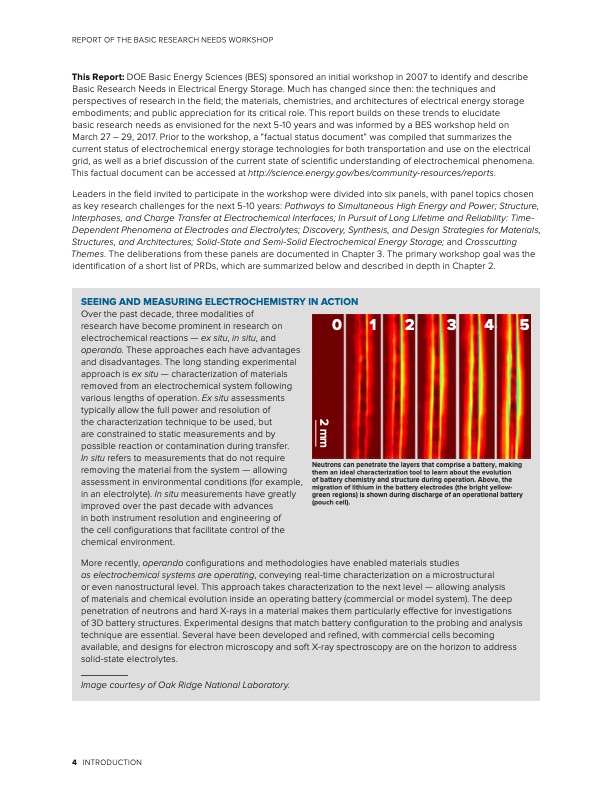
PDF Publication Title:
Text from PDF Page: 010
REPORT OF THE BASIC RESEARCH NEEDS WORKSHOP This Report: DOE Basic Energy Sciences (BES) sponsored an initial workshop in 2007 to identify and describe Basic Research Needs in Electrical Energy Storage. Much has changed since then: the techniques and perspectives of research in the field; the materials, chemistries, and architectures of electrical energy storage embodiments; and public appreciation for its critical role. This report builds on these trends to elucidate basic research needs as envisioned for the next 5-10 years and was informed by a BES workshop held on March 27 – 29, 2017. Prior to the workshop, a “factual status document” was compiled that summarizes the current status of electrochemical energy storage technologies for both transportation and use on the electrical grid, as well as a brief discussion of the current state of scientific understanding of electrochemical phenomena. This factual document can be accessed at http://science.energy.gov/bes/community-resources/reports. Leaders in the field invited to participate in the workshop were divided into six panels, with panel topics chosen as key research challenges for the next 5-10 years: Pathways to Simultaneous High Energy and Power; Structure, Interphases, and Charge Transfer at Electrochemical Interfaces; In Pursuit of Long Lifetime and Reliability: Time- Dependent Phenomena at Electrodes and Electrolytes; Discovery, Synthesis, and Design Strategies for Materials, Structures, and Architectures; Solid-State and Semi-Solid Electrochemical Energy Storage; and Crosscutting Themes. The deliberations from these panels are documented in Chapter 3. The primary workshop goal was the identification of a short list of PRDs, which are summarized below and described in depth in Chapter 2. SEEING AND MEASURING ELECTROCHEMISTRY IN ACTION Over the past decade, three modalities of research have become prominent in research on electrochemical reactions — ex situ, in situ, and operando. These approaches each have advantages and disadvantages. The long standing experimental approach is ex situ — characterization of materials removed from an electrochemical system following various lengths of operation. Ex situ assessments typically allow the full power and resolution of the characterization technique to be used, but are constrained to static measurements and by possible reaction or contamination during transfer. In situ refers to measurements that do not require removing the material from the system — allowing assessment in environmental conditions (for example, in an electrolyte). In situ measurements have greatly improved over the past decade with advances in both instrument resolution and engineering of the cell configurations that facilitate control of the chemical environment. 0 1 2 3 4 5 More recently, operando configurations and methodologies have enabled materials studies as electrochemical systems are operating, conveying real-time characterization on a microstructural or even nanostructural level. This approach takes characterization to the next level — allowing analysis of materials and chemical evolution inside an operating battery (commercial or model system). The deep penetration of neutrons and hard X-rays in a material makes them particularly effective for investigations of 3D battery structures. Experimental designs that match battery configuration to the probing and analysis technique are essential. Several have been developed and refined, with commercial cells becoming available, and designs for electron microscopy and soft X-ray spectroscopy are on the horizon to address solid-state electrolytes. Image courtesy of Oak Ridge National Laboratory. Neutrons can penetrate the layers that comprise a battery, making them an ideal characterization tool to learn about the evolution of battery chemistry and structure during operation. Above, the migration of lithium in the battery electrodes (the bright yellow- green regions) is shown during discharge of an operational battery (pouch cell). 4 INTRODUCTION 2mmPDF Image | Next Generation Electrical Energy Storage

PDF Search Title:
Next Generation Electrical Energy StorageOriginal File Name Searched:
BRN-NGEES_rpt-low-res.pdfDIY PDF Search: Google It | Yahoo | Bing
Sulfur Deposition on Carbon Nanofibers using Supercritical CO2 Sulfur Deposition on Carbon Nanofibers using Supercritical CO2. Gamma sulfur also known as mother of pearl sulfur and nacreous sulfur... More Info
CO2 Organic Rankine Cycle Experimenter Platform The supercritical CO2 phase change system is both a heat pump and organic rankine cycle which can be used for those purposes and as a supercritical extractor for advanced subcritical and supercritical extraction technology. Uses include producing nanoparticles, precious metal CO2 extraction, lithium battery recycling, and other applications... More Info
| CONTACT TEL: 608-238-6001 Email: greg@infinityturbine.com | RSS | AMP |